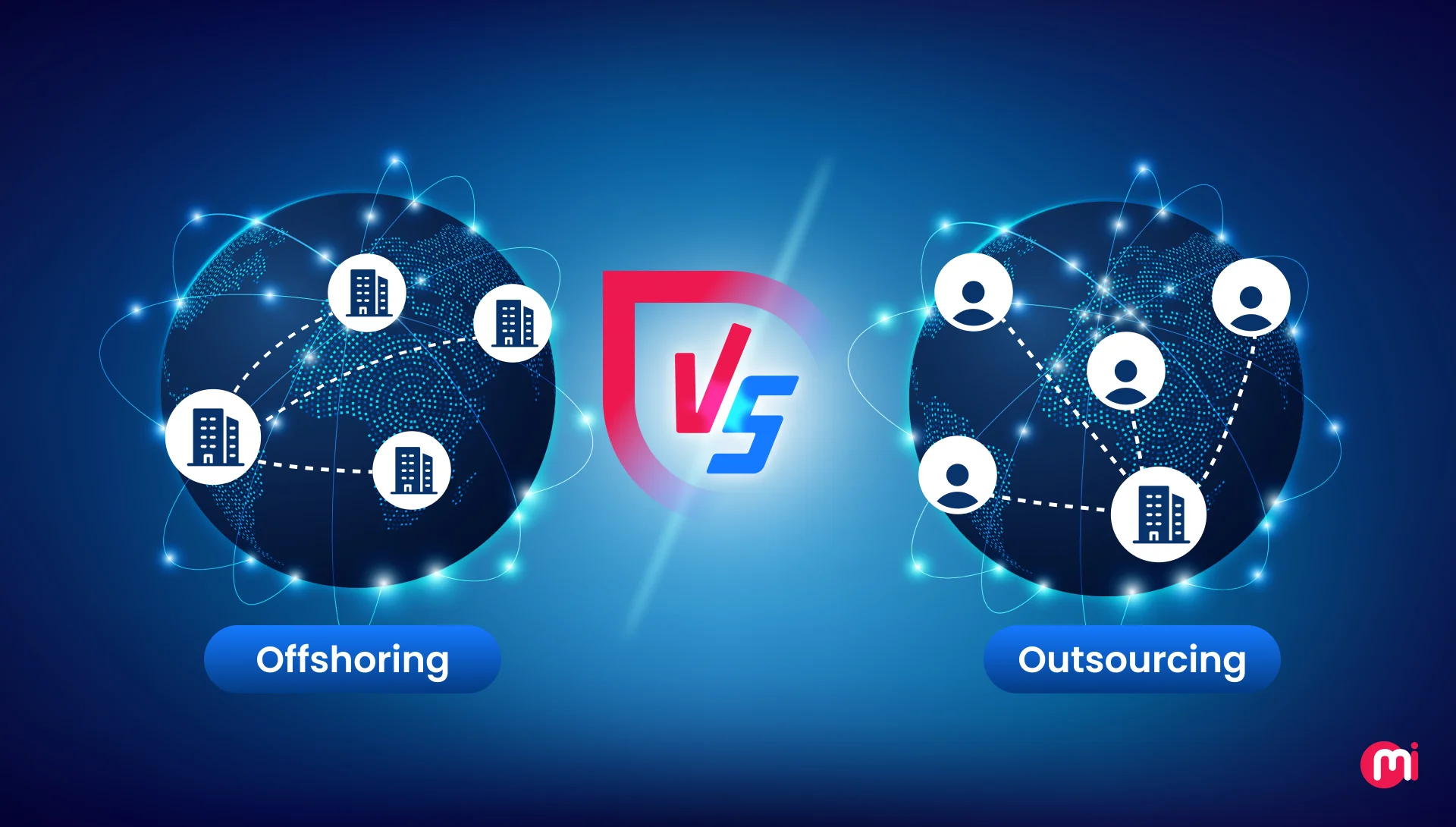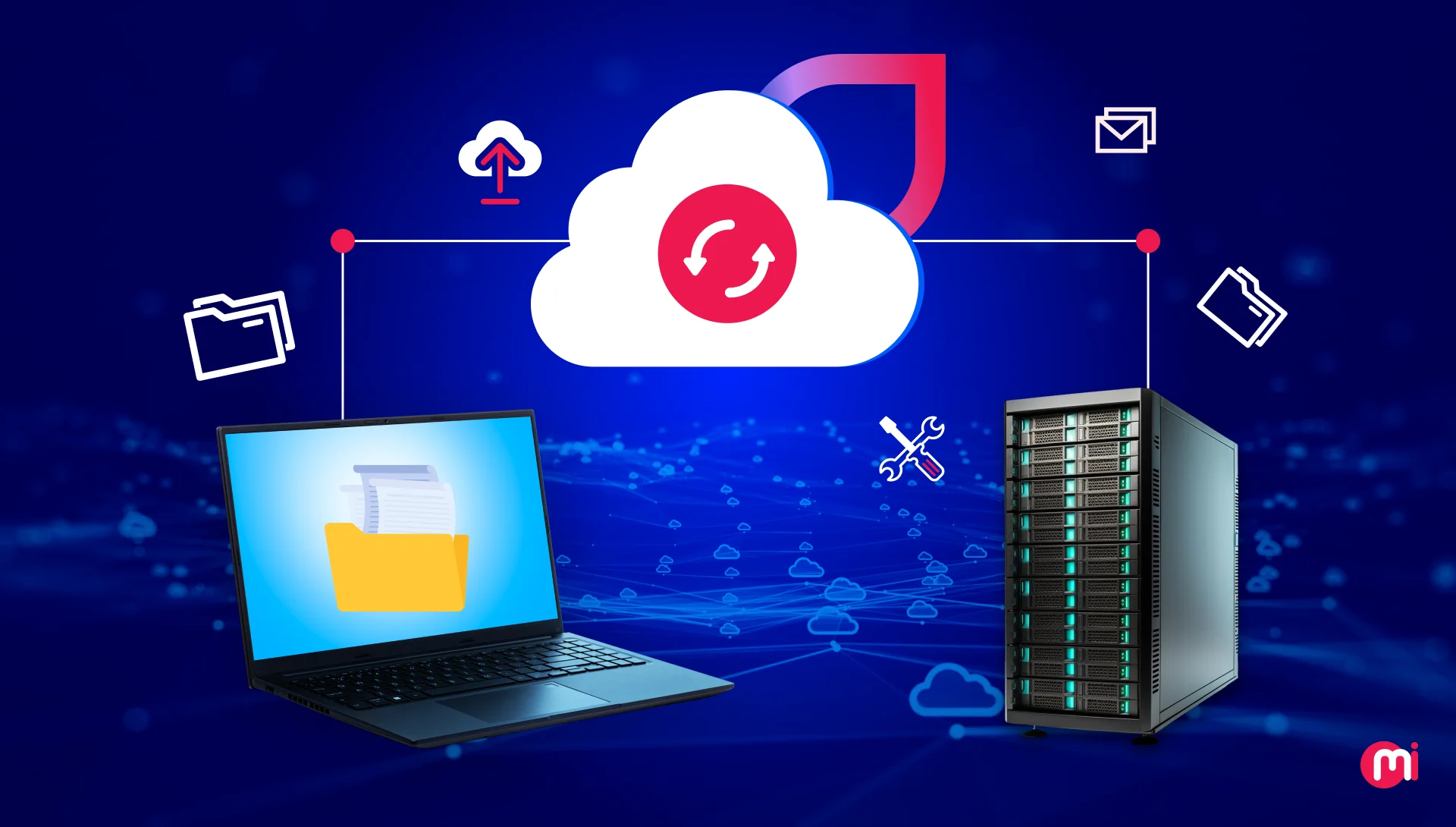Offshoring vs. Outsourcing: What’s Best For Your Next Software Development Project
- Software
- July 17, 2025
The debate around offshoring vs. outsourcing often comes up when businesses look to develop high-end software. Outsourcing simply means handing over your software work to an external team, whether they’re down the street or across the globe. Offshoring is more specific: it’s outsourcing to a team in another country, typically to save costs or access specialized skills. In short, all offshoring is outsourcing, but not all outsourcing involves sending work overseas. This blog breaks down the pros, cons, and core differences to help you decide which model best aligns with your project goals.
Offshoring vs. outsourcing is a long-standing debate when it comes to software projects. Both models offer cost savings and access to global talent, but they’re not the same. However, understanding the difference can be the key to meeting deadlines, maintaining quality, and scaling smart.
But what is outsourcing and offshoring?
Which one is the right fit for your team?
Do they support the software development life cycle (SDLC)?
Should you hand off your entire project to a third-party vendor or build a remote team that works more like an extension of your in-house team?
This blog reveals the difference between offshoring and outsourcing, explores their pros and cons, and looks at scenarios where one fits more than the other. It helps you choose an ideal model that aligns best with your goals, resources, and growth strategy.
What is Offshoring?
Offshoring is a strategic move where a company shifts certain business operations, such as software development, cloud migration solutions and maintenance, or IT support, to another country. Offshoring allows the company to maintain direct oversight and control over the relocated teams. It’s a long-term solution for businesses looking to scale efficiently while staying hands-on with their operations.
Why Do Organizations Need Offshoring?
Organisations turn to offshore software development to achieve faster growth, access specialised talent, and scale without the high costs associated with expanding locally. By leveraging offshore teams, businesses can overcome common hurdles such as tight deadlines, limited budgets, and workforce shortages, while tapping into skilled professionals across the globe. Offshore software development not only reduces operational expenses but also accelerates project delivery and innovation.
Take a practical scenario: a U.S.-based fintech company lands a major client and must roll out new features within three months. Their local developers are already engaged in critical maintenance work, and hiring additional in-house talent could take several months to complete.
Rather than missing the opportunity or stretching the timeline, they offshore to Eastern Europe. The offshore team builds the new features, while the local team maintains stability and ensures smooth integration. As a result, the company meets its timeline, upholds quality, and avoids operational burnout.
In short, offshoring empowers organizations to stay agile, control costs, and deliver faster without compromising on expertise or stretching internal teams beyond their limits.
Pros of Offshoring
Cost Savings: Labor and operational costs are often significantly lower in offshoring destinations, making it ideal for budget-conscious businesses.
Access to Global Talent: Offshoring opens the door to a larger pool of skilled developers and specialists with diverse technical expertise.
Scalability: Companies can quickly scale their teams without the long hiring cycles typical in local markets.
Round-the-Clock Productivity: With teams across time zones, development can continue 24/7, accelerating delivery timelines.
Direct Oversight: Offshoring allows businesses to maintain control over workflows, processes, and team management.
Cons of Offshoring
Time Zone Differences: While they can boost productivity, mismatched working hours may cause delays in communication or decision-making.
Cultural and Language Barriers: Misunderstandings due to cultural differences or language gaps can affect collaboration.
Onboarding and Management: Offshored teams may require more time to align with the company’s culture, tools, and processes.
Data Security Risks: Operating across borders may introduce complexities in managing data protection and compliance standards.
Examples of Offshoring
Microsoft
Microsoft has offshored development and customer service operations to countries like India to optimize costs and maintain global reach.
GitHub
GitHub and Slack have worked with offshore development teams during early growth phases to expand engineering capacity quickly.

What is Outsourcing?
Outsourcing is an effective business practice that involves delegating specific tasks or entire projects to external vendors or third-party service providers. Companies often choose this model when they need to reduce development costs, access specialized skills, or accelerate the time-to-time market without expanding their in-house team.
Why Do Organizations Need Outsourcing?
Organizations turn to software development outsourcing to accelerate delivery, manage costs, and maintain focus on their core objectives. By partnering with an external team, they gain access to specialized expertise without overwhelming internal resources or pausing other critical initiatives.
For instance, a company might be in the middle of a major platform overhaul but also needs to develop a new reporting tool to meet customer demands. Instead of overloading their in-house team or hiring new developers, they choose a trusted software development partner to outsource the secondary project. This way, the primary team stays focused on the main platform while the outsourced team handles the new build, ensuring both projects progress smoothly and hit their targets.
Ultimately, outsourcing empowers businesses to scale efficiently, meet tight deadlines, and keep innovation on track without compromising internal bandwidth.
Pros of Outsourcing
Cost Efficiency: Outsourcing often reduces labor and infrastructure costs, especially when working with vendors in lower-cost regions.
Access to Specialized Talent: Companies can quickly bring in experts for technologies or domains they lack in-house.
Faster Time-to-Market: External teams can work in parallel with internal staff, speeding up development cycles.
Focus on Core Business: Outsourcing extra work lets internal teams stay focused on strategic goals.
Scalability: It’s easy to scale teams up or down based on project requirements without long-term commitments.
Cons of Outsourcing
Less Control: Working with external teams may mean limited oversight of daily workflows or decisions.
Communication Gaps: Time zone differences and language barriers can lead to delays or misunderstandings.
Quality Risks: Without proper vetting, the quality of deliverables may vary across vendors.
Security Concerns: Sharing sensitive data or IP externally may increase security and compliance risks.
Dependency: Long-term reliance on vendors can reduce internal technical growth and knowledge retention.
Examples of Outsourcing
Before being acquired by Facebook, WhatsApp outsourced development work to Eastern Europe, particularly Russia. With a lean U.S.-based team, they relied on an external team to keep costs low while scaling the app quickly.
Spotify
Spotify has maintained its edge in the music streaming space by outsourcing parts of its software development to international teams, enabling faster feature rollouts and agile innovation.

What is the Difference Between Offshoring and Outsourcing
In software development, offshoring and outsourcing are often used interchangeably, but they serve different purposes and involve distinct approaches. Offshoring involves relocating your company’s development operations to another country to benefit from lower costs or a broader talent pool while keeping control in-house.
On the other hand, outsourcing means availing a third-party software development outsourcing services provider to handle specific development tasks or entire projects, often with less direct control.
These two models differ in cost structure, scalability and flexibility, cultural and time zone considerations, quality and oversight, technology and infrastructure, and many other factors. Here is a detailed breakdown of each difference between offshoring and outsourcing:
1. Control and Ownership
Offshoring gives companies full authority over their dedicated software development team. Since the offshore team is part of the organization, you manage workflows, tools, and processes directly, just in a different location. However, outsourcing transfers much of that control to the third-party vendor. While you define the scope and expectations, the external team handles day-to-day decisions and delivery.
So, in the offshoring vs. outsourcing comparison, offshoring suits businesses seeking long-term team integration, while outsourcing works better for quick execution without much management involved.
2. Cost Structure
When comparing offshoring vs. outsourcing in terms of software development cost structure, offshoring usually involves higher upfront expenses, like setting up infrastructure, recruiting, and long-term operations, though it can reduce costs over time with lower regional salaries. In contrast, outsourcing offers a more flexible, on-demand pricing model. You pay only for what you need, without managing full-time teams or facilities.
Hence, offshoring is cost-effective for sustained development with more control, while outsourcing suits short-term or specialized needs with predictable costs.
3. Technology and Infrastructure
In the offshoring vs. outsourcing comparison, technology and infrastructure play distinct roles. Offshoring requires the company to invest in and maintain its infrastructure, including tools, security, and development environments. This allows for tailored setups and deeper integration but involves higher setup and maintenance efforts.
However, outsourcing providers come equipped with their technology stacks and established infrastructure. This accelerates onboarding and reduces setup costs but offers less customization and control.
If you need full-stack control and customized environments, offshoring fits better. For faster deployment without managing backend systems, outsourcing delivers convenience with minimal tech responsibility.

4. Cultural and Time Zone Considerations
With offshoring, companies often work across significant time zone gaps, which can slow communication but also enable round-the-clock productivity. Cultural alignment may require more onboarding effort to ensure smooth collaboration.
Meanwhile, outsourcing, depending on the provider’s location, can offer more flexibility, such as nearshore teams in similar time zones or vendors with proven cross-cultural experience.
Hence, offshoring demands stronger internal coordination, while outsourcing gives you more options to choose culturally compatible teams or align time zones with your preferred working hours.
5. Quality and Oversight
In an offshoring vs outsourcing comparison for quality and oversight, offshoring offers greater control. Since the team is part of your organization, you can directly manage processes, set standards, and monitor output, leading to more consistent quality over time.
While efficient, outsourcing can limit your visibility into day-to-day operations. Quality depends heavily on the vendor’s practices, which may vary. Regular check-ins, SLAs, and clear communication are essential to maintain standards.
Ultimately, offshoring suits companies needing tight oversight and long-term consistency, while outsourcing works best when you trust the vendor’s expertise and need quicker execution with less managerial load.
6. Scalability and Flexibility
Scalability and flexibility are the major differences between offshoring and outsourcing, as offshoring supports long-term growth by building dedicated teams that scale gradually under your direct control. While it may take more time and planning to expand, it ensures consistency and alignment with your internal goals.
On the flip side, outsourcing is more flexible for short-term software product development projects. It allows rapid team scaling and quick access to specialized talent without the burden of recruitment or infrastructure.
In this context, offshoring favors steady, controlled scaling, while outsourcing offers on-demand agility and is ideal for fast-moving or variable project requirements.
7. Nature of Work
The nature of work is an important difference between outsourcing and offshoring, as it often influences whether offshoring or outsourcing fits well or not. Offshoring is typically used for long-term, core development tasks where continuity, deeper integration, and in-house oversight are important, such as building proprietary software or maintaining complex systems.
On the other hand, outsourcing is ideal for project-based or specialized tasks, like testing, UI UX design solutions, or feature-specific development, where speed and external expertise matter more than full control.
In short, offshoring vs. outsourcing often comes down to how central and ongoing the work is. Strategically embedded work favors offshoring, while task-driven needs to align with outsourcing.
8. Reliability
Offshoring often delivers higher long-term reliability, as teams are fully integrated, aligned with company goals, and trained in internal standards. You just have to maintain oversight which supports consistent output over time.
While potentially faster to set up, outsourcing can vary in reliability depending on the vendor’s processes, talent pool, and workload. Strong contracts and communication protocols are key to ensuring consistent performance.
Ultimately, offshoring provides greater reliability for sustained, mission-critical development, while outsourcing is an ideal choice for well-defined, short-term projects if the partner is carefully vetted.

Offshoring vs. Outsourcing – At a Glance
Here’s a comprehensive overview of the key difference between offshoring and outsourcing. This quick comparison highlights how each model impacts control, cost, scalability, and more.
| Aspect | Offshoring | Outsourcing |
| Control & Ownership | More control, retained ownership | Less control, vendor-managed |
| Cost Structure | Long-term savings, higher setup | Flexible pricing, low entry cost |
| Scalability | Good for structured scaling | Highly flexible, quick to scale |
| Culture & Time Zone | Higher barriers possible | Varies by vendor location |
| Quality & Oversight | Easier with dedicated teams | Vendor-dependent |
| Tech & Infrastructure | Requires setup or mature partner | Uses vendor’s existing setup |
| Nature of Work | Core, long-term projects | Specialized, short-term tasks |
| Reliability | High with alignment | Varies by vendor |
Offshoring vs. Outsourcing: When to Choose What
While both models help cut costs and expand capabilities and support agile software development, their application and impact vary significantly. Understanding the difference between outsourcing and offshoring is important, especially when the right choice can help you avoid missteps and build a more efficient development pipeline. Here’s how you can choose the best one:
Choose Offshoring When
- You need software consulting services, long-term or managed IT services
- The work involves core systems or sensitive intellectual property
- Maintaining full control over team workflows and output is critical
- You’re prepared to invest in infrastructure and team integration
- You want better alignment with internal standards and company culture
- Continuous collaboration and knowledge retention are priorities
Choose Outsourcing When
- You have short-term, modular, or clearly defined project needs
- Speed, flexibility, and cost-efficiency are more important than control
- You require niche expertise that your in-house team lacks
- You want to minimize setup time and operational responsibilities
- You’re looking to scale quickly without long-term commitments
- Leveraging vendor infrastructure and proven workflows fits your needs
Offshoring vs. Outsourcing: Final Verdict
Offshoring and outsourcing have reshaped how modern software projects are built and delivered. As global collaboration becomes the norm, both models continue to offer businesses the flexibility, talent access, and scalability needed to stay competitive.
Choosing the right model is no longer just about cost but it’s about aligning with your workflow, timeline, and growth vision. Ultimately, the software development company you choose to offshore or outsource your project will make all the difference, shaping project execution, delivery, and future growth.

Searching for a Reliable Software Development Company? MindInventory is the Best Choice!
MindInventory is a trusted partner for businesses looking to hire software developers through flexible offshoring or outsourcing models. Our team delivers scalable web, mobile, and enterprise software development solutions across industries.
Whether you want to offshore and embed dedicated developers under your full control or outsource specialized modules with flexible vendor partnerships, we adapt to your business needs.
We offer seamless team integration with vetted developers skilled in full-stack development, emerging technologies like AI, and industry-specific workflows. Our talent pool spans front-end, back-end, mobile, and cloud engineering with the agility to scale up or pivot as needed.
No matter the model, we prioritize transparency, code quality, and collaboration. With robust infrastructure, a proven track record, and a security-first mindset, we offer services that align with your product vision and deliver long-term value.
FAQs on offshoring and outsourcing software development
Yes, you can offshore the project without outsourcing. Offshoring refers to relocating work to another country while keeping it in-house, meaning your company still owns and manages the team. Outsourcing involves handing tasks to an external vendor. So, offshoring without outsourcing is simply building your own remote team abroad.
Outsourcing offers speed, flexibility, and access to specialized skills through third-party vendors. Offshoring provides greater control, long-term scalability, and cost efficiency with dedicated teams abroad. Each has its strengths, and the right choice depends on your project goals and resources.
No, offshoring is not always outsourcing. Offshoring means relocating work to another country, but the team can still be part of your company. Outsourcing involves hiring an external vendor, which can happen locally or globally. So, offshoring can be done without outsourcing if you retain full control over the team.
Offshoring risk refers to the potential challenges and uncertainties businesses face when relocating operations to another country. These risks include communication barriers, time zone differences, cultural misunderstandings, data security concerns, legal and regulatory compliance issues, and reduced oversight. If not managed properly, offshoring risks can impact productivity, quality, and overall project success.
Outsourcing involves hiring an external company to handle certain tasks or services, often to save costs or access specialized expertise. On the other hand, insourcing means assigning those tasks to internal teams within the organization. While outsourcing leans on external talent, insourcing builds and uses in-house capabilities.
Insourcing is the practice of performing tasks or operations internally within the organization rather than delegating them to third-party providers. It allows companies to maintain tighter control over quality, data security, and processes and is often used for strategic functions or when aligning teams closely with business goals is critical.













